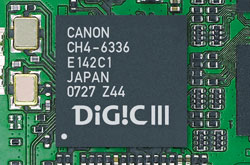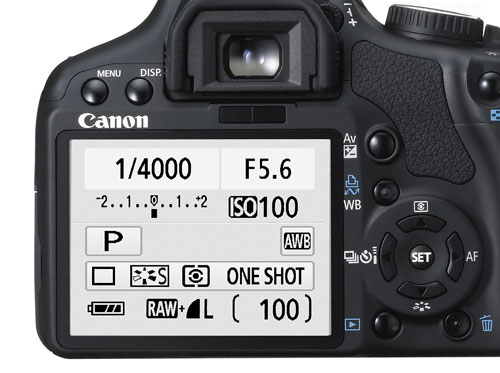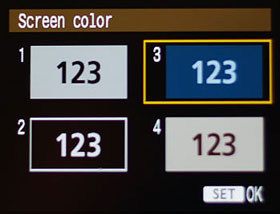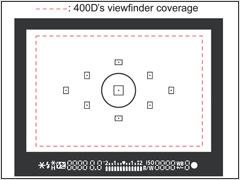Canon XSi: 12.2 Megapixels, Image Stabilized Lens, and Double Live View
by Wesley Fink on May 5, 2008 3:00 AM EST- Posted in
- Digital Camera
XSi Features
Some of the more significant improvements to the XSi were taken from the Canon 40D and the Pro Canons. The processing heart of the XSi is the Digic III which is the same chip used in the 40D.

This endows the Canon XSi with a speedy 14-bit Analog-to-Digital converter. Digic III was widely praised when it was first introduced last fall as dual Digic III processors in the $8000 EOS 1Ds Mark III and a single Digic III in the Canon 40D. Now the entry-level XSi has the same processor as these Canon top-line cameras.

The 3" LCD used on the XSi is the largest LCD currently used on an entry-level DSLR. Others are 2.7" and 2.5". This is also the same 230,000 pixel 3" LCD used on the 40D and the 1Ds Mark III. This is not as finely detailed as the higher-resolution 3" LCD used on the Nikon D300 and the Sony A700, but those are $1800 and $1400 cameras compared to $800 for the XSi body alone. The 3" display can even be customized by choosing one of four color schemes.

Our review of the Sony A350 complained about the horrible .74x magnification and "looking down a tunnel" view of the A350. All of the cropped sensor cameras (i.e. most everything but top Pro DSLRs) are challenged in producing large, bright viewfinders compared to 35mm full-frame cameras.

Canon continues to improve viewfinders - even those in their entry XSi camera. Here you can see the improved view of the .87x magnification XSi compared to the .80x magnification of the XTi and XT viewfinders. The original Digital Rebel from 2003 featured a decent .88x viewfinder that was sacrificed to the size shrink of the Digital Rebel XT model. With the XSi the viewfinder of the entry Canon is back to the magnification of the original Digital Rebel. Brightness also appears to be improved with the XSi the brightest finder of the series.
While the .88x is a welcomed improvement, the new 40D prosumer model has an even better viewfinder with a .95x view. Since the 40D and XSi sensors are the same size (22.2x14.8mm), the viewfinder magnifications are directly comparable. However, comparing the XSi viewfinder to its competitors - the Nikon D60, Sony A350/A300, and Olympus E-510/E-420 - shows the Canon XSi to have the best viewfinder in its class.
The 9-point AF module appears similar to the 9-point AF in the Canon 40D. Working range AF specifications are the same EV range of -0.5EV to 18EV. However, the 40D adds an additional diagonal cross-type sensor with greater precision for f2.8 lenses, providing better support for fast Canon L lenses.
The XSi is the first in the Digital Rebel series to feature a Spot Metering option. Every review has complained about this missing feature since the launch of the original Digital Rebel, and Canon has finally listened. The spot meter is 4% of the viewfinder and available only on the center spot. In the picture above showing the viewfinder, the spot metering area is represented by the circle around the center AF spot. This is also visible in the XSi viewfinder.
ISO Speed Display and Auto ISO
Users have also asked Canon to add ISO speed to the viewfinder display. In the XSi that is finally a reality. Auto ISO is also a more useful feature since it now works over a wider range, at least to 800 in our tests and the auto-selected ISO is also displayed in the viewfinder and on the rear LCD dynamically. However, even in total darkness we could not coax Auto ISO to select 1600, and in the brightest of shooting situations the XSi would not auto select ISO 100.










56 Comments
View All Comments
pinto4402 - Monday, May 5, 2008 - link
Your observation about Canon's overly warm/red WB in tungsten lighting is shared by many camera reviewers/users. It's a "problem" that has been noted for a long time. Some people actually prefer the overly warm colors, though. I'm sure this is the reason why Canon has never fixed their WB.Deadtrees - Monday, May 5, 2008 - link
"Working range AF specifications are the same EV range of -0.5EV to 18EV. However, the 40D adds an additional diagonal cross-type sensor with greater precision for f2.8 lenses, providing better support for fast Canon L lenses."- Not trying to be picky or anything but that is somewhat misleading as not all L lenses have aperture values faster than f/2.8.
-------------------------------------------------------------------
"Overall, the Sony A350 actually does better against the Canon XSi than we really expected and acquits itself quite well for a higher resolution sensor that should be showing greater noise than the Canon XSi. Resolution and noise control to ISO 1600 on the Sony holds its own against a sensor maker than has been the low-noise standard since DSLRs began."
- Keep in mind that A350 utilizes quite agressive noise deduction algorithms resulting smudged water color like images. If you think less noise is good no matter what, I guess it's not so bad. But, what about details that are lost? Do you really want over 10mp dslr images to show details as cell phone cameras? Hell, in that case, even point-and-shoot panasonic cameras that are known for crazy noise reduction algorithm can compete head to head with Nikon D3.
---------------------------------------------------------------------
BTW, I really suggest you to change the test subject. It's glossy coated hardboard papers which makes it virtually impossible to see the loss of details caused by insance noise reduction algorithms.
Lord 666 - Monday, May 5, 2008 - link
Wes,If you are comparing the XTi vs. XSi vs. 40D, why not include the D300 as well to compare against?
Wesley Fink - Monday, May 5, 2008 - link
We will include the D300 results in Part 2 of our Digital Sensor article. We will be comparing resolution and noise in different sensor categories, such as 14 megapixel, 12 megapixel, and 10 megapixel.I did toy with the idea of including the D300 in comparisons in this review, but I figured Canon to past Canon XTi to top Canon prosumer 40D was a bit more logical than a $800 body to a $1800 body. I'll leave that comparison for the digital sensor article.
complectus - Monday, May 5, 2008 - link
Is that a Frank Lloyd Wright house in 2 of the Sample Images?Wesley Fink - Monday, May 5, 2008 - link
Yes it is Frank Lloyd Wright. I am fortunate that a real Wright house is in my neighborhood. The furniture was also custom built for the rooms in th eWright house, as was typical of many of his home designs.It was built in the early 1900's and is contemporary to the other homes in the photographs. I figured someone would catch it.
pinto4402 - Monday, May 5, 2008 - link
For about five minutes, I was interested in the Xsi as a lightweight backup camera body for event photography. However, the lack of a CF card slot completely nixes this idea. It doesn't make any sense for Canon to switch from CF to SD, other than to attract P&S owners who want to migrate to a DSLR. By doing so, however, Canon effectively excluded us existing DSLR owners who already have many of their lenses and who would be more likely to purchase. I can tolerate the Xsi's plastic body, but I'm not going to invest in new storage media just to use this camera.Wesley Fink - Monday, May 5, 2008 - link
You can buy a 16GB class 6 hi-speed SD card for $55, a 4GB Class 6 for about $20, or an 8GB for around $30. I can't believe that small expense would keep you from buying and using the XSi if you really wanted to.Nikon uses SD on the D80 and D60, Pentax uses it on the K20D and K200D. Sony still uses CF, but new Sony lenses cost a lot more than today's cheap SD and CF memory.
RDaneel - Monday, May 5, 2008 - link
I have no problem with AT doing camera reviews, I think it's a valuable perspective for hobbyists and prosumers. Obviously AT isn't going to review $1500 lenses...That being said, this review reads more like Canon ad copy than a real comparative review. There isn't any serious examination of the image quality, and it feels like more effort is spent in comparing the number of AF points and megapixels than really looking at the camera as a DSLR system or really talking about IQ. Just kind of a disappointment, normally the objectivity on AT is a bit better. Did the author get to keep the free press sample? ;)
Wesley Fink - Monday, May 5, 2008 - link
There was no Press sample - not even a loaner. We had to buy the XSi that was reviewed. The same goes for the Nikon D60 and Sony A350 that were compared to the XSi. Since we bought them all we owe nothing to any manufacturer.The XSi won't replace my D300 or my Pentax K20D, but it is a really superb entry camera.